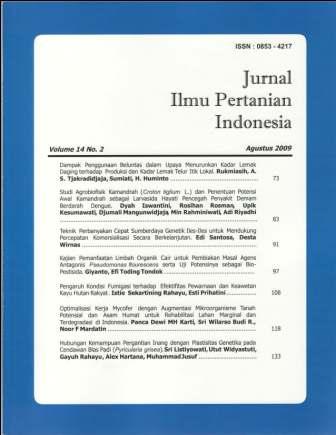Studi agrobiofisik kamandrah (croton tiglium L.) dan penentuan potensi awal kamandrah sebagai larvasida hayati pencegah penyakit demam berdarah dengue
Abstract
The aim of the research is to obtain the ecological condition and propagation of kamandrah (Croton tiglium L.) and determination of its potency as biological larvacidal for preventing dengue haemorraghic fever. Agrobiophysic study indicated that Croton tiglium L. plant need full sunlight(> 70 %). low intensity of sunlight could decrease the ability of plant to produce seed. The plant could grow well on podzolic land (30-50 m upon sea surface). Seed of kamandrah from Ampah has growth percentage of 43.8 °/o, height of 27.5 em, stem diameter of 5 em, total leaves of 10, and total primary branches of 2. Phytochemical assay resulted that among other part of Kamandrah, Kamandrah seed has highest alkaloid content. Because alkaloid compound has high larvicidal activity, kamandrah seed has high potency as larvicide. Among all of extracts of part of plant, oil of Croton tiglium L. has the highest potency as biological larvacidal with 863.67 ppm of LC50 for 24 hours of treatment.Downloads
References
Antonio, S., Maria, L., F. Salatino, Giuseppina, N. 2007. “Traditional Uses, Chemistry and Pharmacology of Croton species (Euphorbiaceae)”. Jurnal Braz. Chem Soc. Vol 18, No 1, 11-33, 2007.
Bandara, K.A., Kumar, V., Jacobsson, U., Molleyres L.P. 2000. “Insecticidal Piperidine Alkaloid from Microcos paniculata Stem Bark. Phytochemistry. 2000 May;54(1):29-32
Carvalho, et.al., 2003. ”Larvacidal activity of the essential oil from Lippia sidoldes Cham against Ae. Aegypti Linn”, Mem Inst Oswaldo Cruz 98:565-571.
Cavalcanti, et.al., 2004. ”Larvacidal activity of the essential oil from Brazilian plants against Ae. Aegypti Linn”, Mem Inst Oswaldo Cruz 99:541-544.
Chansang, et al., 2005. ”Mosquito larvicidal activityof aqueous extracts of long pepper (Piper retrofractum Vahl) from Thailand, Journal of Vector Ecology.30(2):195-200.
Harborne, J.B. 1996. Metode Fitokimia: Cara Menganalisis Tanaman. Terjemahan K. Padmawinata dan I Sudiro. Bandung: Institut Teknologi Bandung.
Metcalff, C.L. 1985. “Destructive and useful insect their habits and control”, 4TH Ed. Hill Book Company, INC New York.
Noegroho, S. Mulyaningsih. 1997. Aktivitas larvasida minyak atsiri daun jukut Hyptis suaveolens (L) Poit, terhadap larva nyamuk Aedes aegypti, instar IV dan analisis Kromatografi Gas - Spektroskopi Massa. Maj Farm Ind (MFI) 8(4): 11.
Pridgeon, J.W., Meepagala, K.M., Becnel, J.J., Clark, G.G., Pereira, R.M., Linthicum, K.J. 2007. “Structure-Activity Relationships of 33 Piperidines as Toxicants Against Female Adults of Aedes aegypti (Diptera: Culicidae)”. Journal of Medical Entomology, Volume 44, Number 2, March 2007 , pp. 263-269(7).
Sinar Harapan. 2002. Tanaman kemandah pembunuh jentik nyamuk demam berdarah. Harian Umum Sinar Harapan 6 Februari 2002: 1
Thamrin, U.2002. “Tanaman kemandah pembunuh jentik nyamuk demam berdarah”, Sinar harapan 6 Februari 2002.
This journal is published under the terms of the Creative Commons Attribution-NonCommercial 4.0 International License. Authors who publish with this journal agree to the following terms: Authors retain copyright and grant the journal right of first publication with the work simultaneously licensed under a Creative Commons Attribution-NonCommercial 4.0 International License. Attribution — You must give appropriate credit, provide a link to the license, and indicate if changes were made. You may do so in any reasonable manner, but not in any way that suggests the licensor endorses you or your use. NonCommercial — You may not use the material for commercial purposes.



















